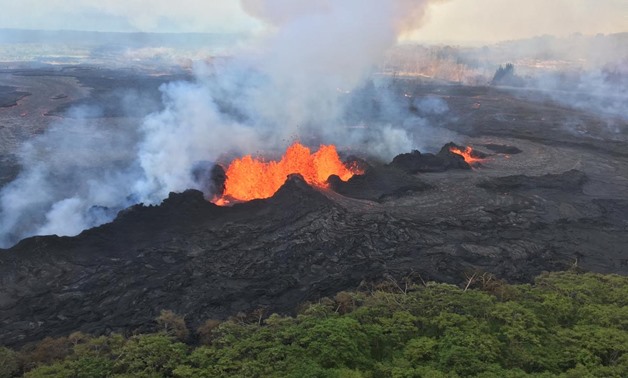
Hawaii volcano belches new ash plume as geothermal wells secured from harm - Reuters
VOLCANO, Hawaii - 24 May 2018: The restive Kilauea Volcano belched clouds of ash into the skies over Hawaii's Big Island twice more on Wednesday as civil defense authorities reported that pressurized geothermal wells at a nearby power plant had been secured from approaching lava.
The latest back-to-back upheavals of ash from the main summit crater of Kilauea -- one before dawn and another several hours later -- came on the 21st day of what geologists rank as one of the biggest eruption cycles in a century from one of the world's most active volcanoes.
The earlier ash plume rose to a height of 8,000 feet (2.44 km), authorities said.
The Hawaii County Civil Defense agency warned in its latest bulletin that residents downwind of Kilauea should take care to avoid exposure to ash, which can cause eye irritation and breathing difficulties, particularly in people with respiratory problems.
Authorities also said that emissions of sulfur dioxide gas, harmful if inhaled, remained at high levels from newly opened lava-spewing fissures in the ground running through populated areas on the eastern flank of the volcano.
"Residents in the affected area should be prepared to take leave of the area with little notice due to gas or lava inundation," the bulletin said.
One major potential hazard that appeared to have been brought under control was at the Puna Geothermal Venture (PGV) plant, which provides about a quarter of the Big Island's electricity.
Lava from an active fissure nearby had flowed onto the property early this week, posing the risk of toxic gases being released in the event the molten rock encroached into any of three pressurized deep-underground wells.
Utility crews racing to quench the wells with cold water and cap the well heads with iron plugs before lava could reach them managed to secure the site. The civil defense agency reported on Wednesday, "there is no immediate threat to any of the wells at PGV."
However, stream of red-hot lava destroyed a former geothermal project site adjacent to the PGV grounds, civil defense said.
Authorities also were monitoring hazards from noxious clouds of acid fumes, steam and fine glass-like particles -- called laze, a mix of lava and haze -- emitted into the air from lava streams pouring into the Pacific Ocean on the south end of the island, about 3 miles (4.8 km) east of the geothermal plant.
Kilauea rumbled back to life on May 3 as it began extruding lava and sulfur dioxide emissions through a series of fissures, marking the latest phase of an eruption cycle that has continued nearly nonstop for 35 years.
The occurrence of new lava vents, now numbering about two dozen, have been accompanied by flurries of earthquakes and periodic eruptions of ash, volcanic rock and toxic gases from the volcano's summit crater.
Geologists say Kilauea has since entered a more violent phase, in which larger volumes of molten rock are oozing from the ground and traveling farther than before.
At least 44 homes and other structures have been destroyed in the Leilani Estates and Lanipuna Gardens area of the Puna district, and a man was seriously injured on Saturday when a plate-sized chunk of molten shot out of a fissure and struck him on the leg.
Two thousand people have been ordered from their homes due to lava flows and sulfur dioxide gas. The Hawaii National Guard has warned of more mandatory evacuations if further highways are blocked.

Comments
Leave a Comment